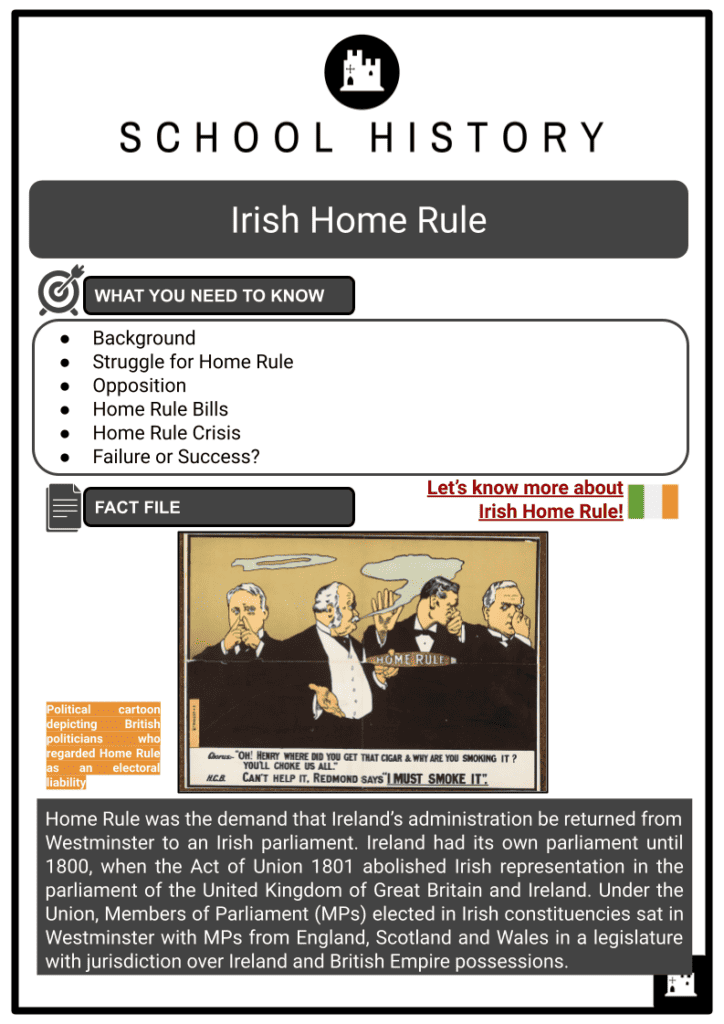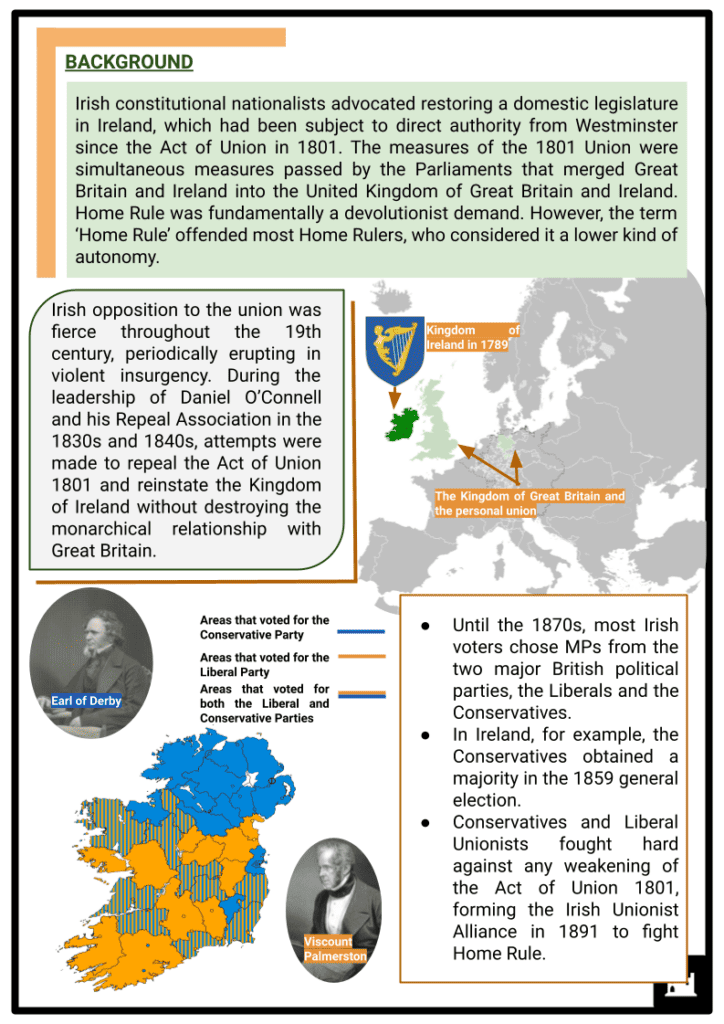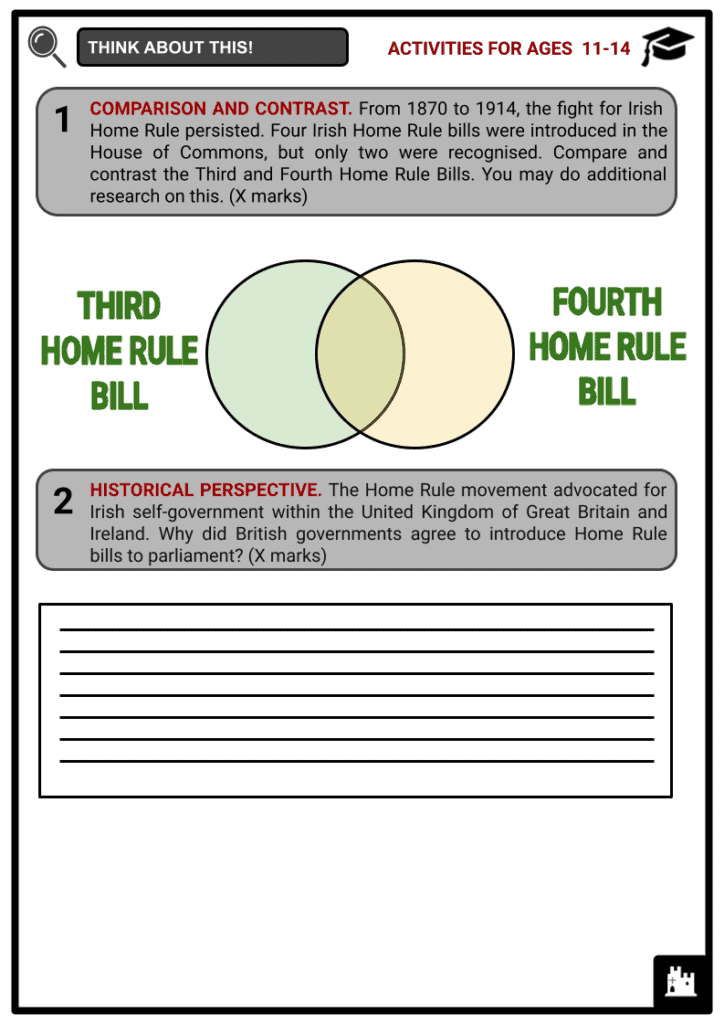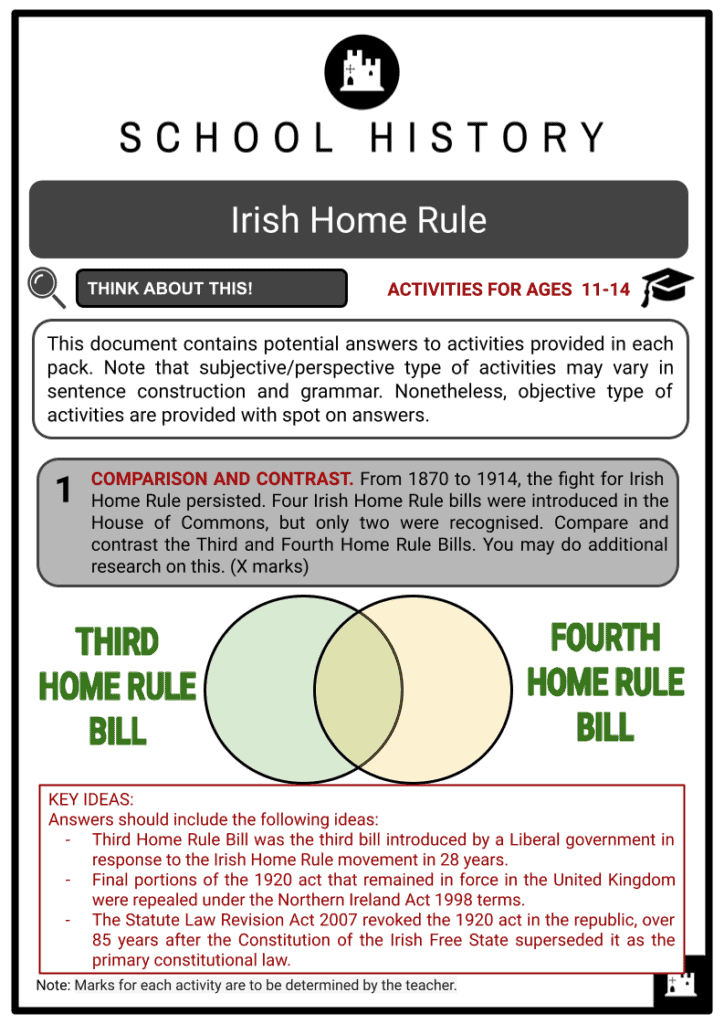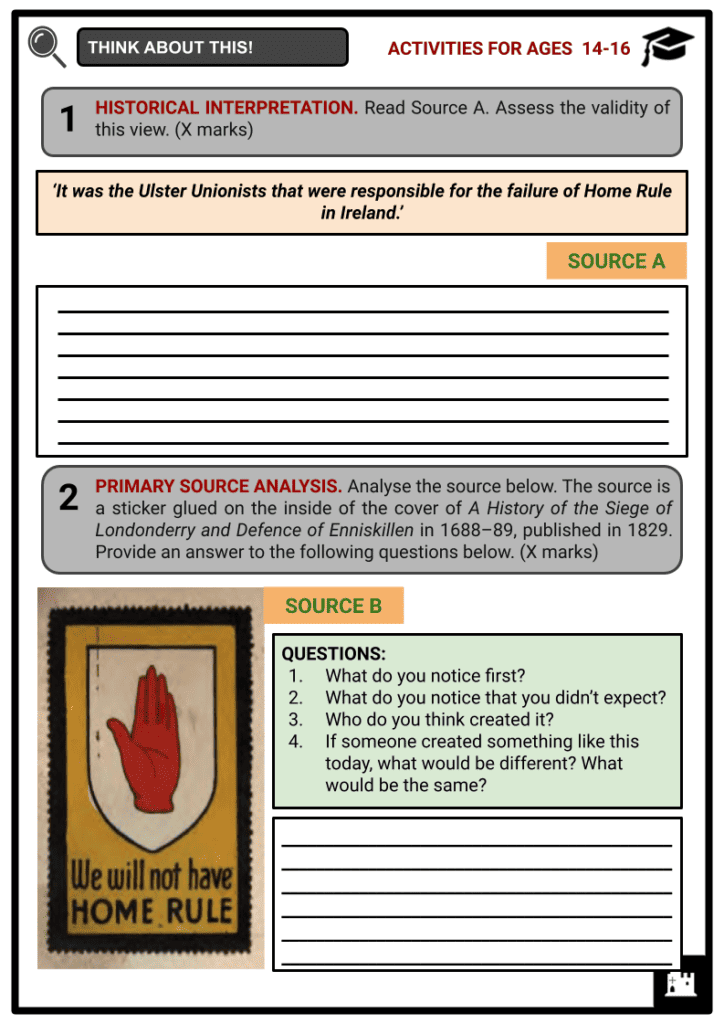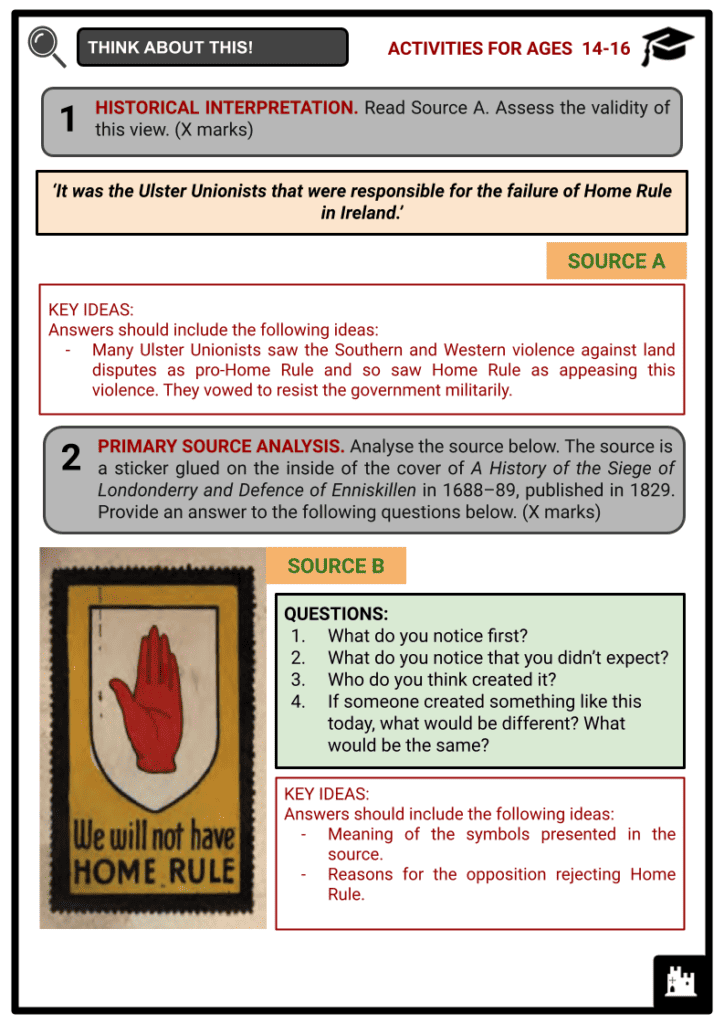Irish Home Rule Worksheets
Do you want to save dozens of hours in time? Get your evenings and weekends back? Be able to teach about the Irish Home Rule to your students?
Our worksheet bundle includes a fact file and printable worksheets and student activities. Perfect for both the classroom and homeschooling!
Summary
- Background
- Struggle for Home Rule
- Opposition
- Home Rule Bills
- Home Rule Crisis
- Failure or Success?
Key Facts And Information
Let’s know more about Irish Home Rule!
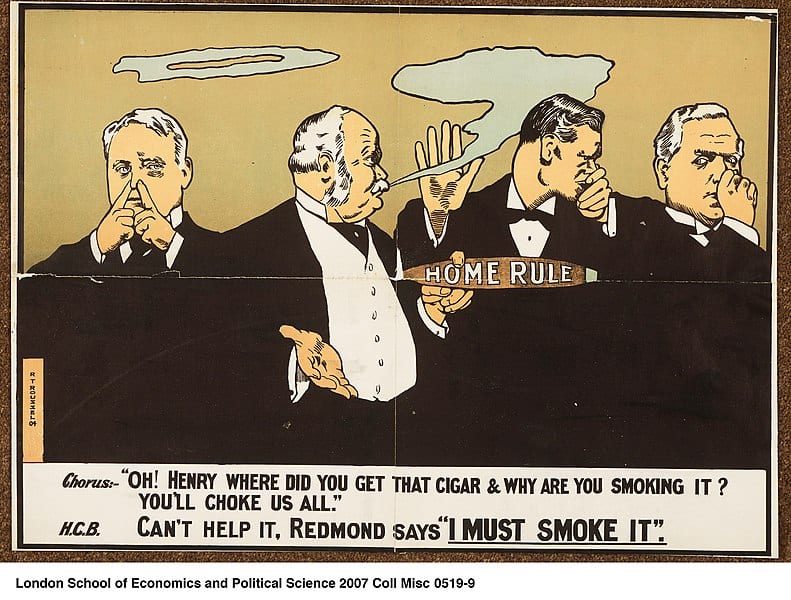
Home Rule was the demand that Ireland’s administration be returned from Westminster to an Irish parliament. Ireland had its own parliament until 1800, when the Act of Union 1801 abolished Irish representation in the parliament of the United Kingdom of Great Britain and Ireland. Under the Union, Members of Parliament (MPs) elected in Irish constituencies sat in Westminster with MPs from England, Scotland and Wales in a legislature with jurisdiction over Ireland and British Empire possessions.
BACKGROUND
- Irish constitutional nationalists advocated restoring a domestic legislature in Ireland, which had been subject to direct authority from Westminster since the Act of Union in 1801. The measures of the 1801 Union were simultaneous measures passed by the Parliaments that merged Great Britain and Ireland into the United Kingdom of Great Britain and Ireland. Home Rule was fundamentally a devolutionist demand. However, the term ‘Home Rule’ offended most Home Rulers, who considered it a lower kind of autonomy.
- Irish opposition to the union was fierce throughout the 19th century, periodically erupting in violent insurgency. During the leadership of Daniel O’Connell and his Repeal Association in the 1830s and 1840s, attempts were made to repeal the Act of Union 1801 and reinstate the Kingdom of Ireland without destroying the monarchical relationship with Great Britain.
- Until the 1870s, most Irish voters chose MPs from the two major British political parties, the Liberals and the Conservatives.
- In Ireland, for example, the Conservatives obtained a majority in the 1859 general election.
- Conservatives and Liberal Unionists fought hard against any weakening of the Act of Union 1801, forming the Irish Unionist Alliance in 1891 to fight Home Rule.
STRUGGLE FOR HOME RULE
- John O’Mahony and Michael Doheny created the Fenian Brotherhood, an Irish Republican movement in the United States, in 1858. By representing members of the Fenian Brotherhood in court, former Conservative barrister Isaac Butt was essential in developing links between constitutional and revolutionary nationalism.
- In May 1870, Butt founded the Irish Home Government Association, a new moderate nationalist movement.
- It was reorganised as the Home Rule League in November 1873 under the direction of William Shaw. The League aimed to grant Ireland partial self-government as part of the United Kingdom.
- League-affiliated candidates gained 53 seats in parliament in the 1874 general election.
- Butt passed away in 1879. In 1880, a radical young Protestant landowner named Charles Stewart Parnell became chairman, and the League won 63 seats in the 1880 general election. In 1882, Parnell formalised the Home Rule League into the Irish Parliamentary Party (IPP), which became a major political force.
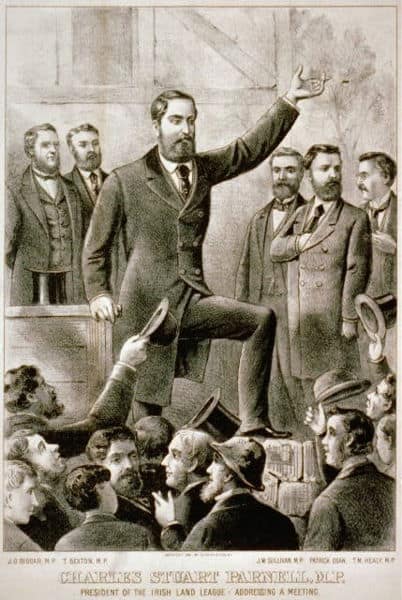
Charles Stewart Parnell speaking in front of a crowd during a meeting - The most crucial event in creating a more powerful Home Rule movement occurred in 1880 when Charles Stewart Parnell was elected party chairman.
- Parnell was considered an expert organiser. From parish to parliament, he operated the party very well, and by combining the desire for Home Rule with the rising movement for tenant rights in Ireland, Home Rule became an extraordinarily potent political force.
- Between the land question and the campaign for Home Rule, Irish concerns dominated parliamentary time at Westminster in the 1880s and occasionally after that.
OPPOSITIONS
- Under British Prime Minister William Ewart Gladstone, the Liberals attempted to pass two Home Rule legislations. Gladstone had become passionately dedicated to granting Irish Home Rule after being impressed by Parnell in 1885. During his address on Home Rule, Gladstone urged the parliament to pass the Irish Government Bill 1886 and grant Home Rule to Ireland with honour instead of being forced to do so out of humiliation.
I wish now to refer to another matter. I hear constantly use the terms Unionists and Separatists. But what I want to know is, who are the Unionists? I want to know who the Separatists are. I see this Bill described in newspapers of great circulation and elsewhere as a Separation Bill. Several Gentlemen are opposite adopt and make that style of description their own. Speaking of that description, it is the merest slang of vulgar controversy. Do you think this Bill will tend to separation?
- An address to the House of Commons on Home Rule for Ireland by British Prime Minister William Ewart Gladstone MP.
- The Irish Government Bill 1886 sparked riots in Belfast throughout the summer and autumn of 1886, killing many people and forcing the Liberal Unionist Association to break from the main Liberal Party. The Liberal Unionist Association worked with Lord Salisbury’s Conservatives on the question of Home Rule until 1914.
- Gladstone was temporarily deposed as a result of the bill’s rejection. Following Parnell’s death, Gladstone, having returned to power following the 1892 general election, launched a second attempt to implement Irish Home Rule with the Irish Government Bill 1893, which he controversially crafted without the knowledge of other MPs.
- Following the defeat, the new Liberal leader, Lord Rosebery, promised Salisbury that the majority vote of English MPs would have a veto over any future Irish Home Rule bills.
HOME RULE BILLS
- The four Irish Home Rule bills that were introduced in the House of Commons of the United Kingdom in the late 19th and early 20th centuries had the goal of granting self-government and independence as a nation to the entirety of Ireland within the United Kingdom of Great Britain and Ireland, as well as to reverse portions of the Acts of Union 1801. The bills were:
- 1886: First Irish Home Rule Bill
- 1893: Second Irish Home Rule Bill
- 1912–14: Third Irish Home Rule Bill
- 1920: Fourth Irish Home Rule Bill
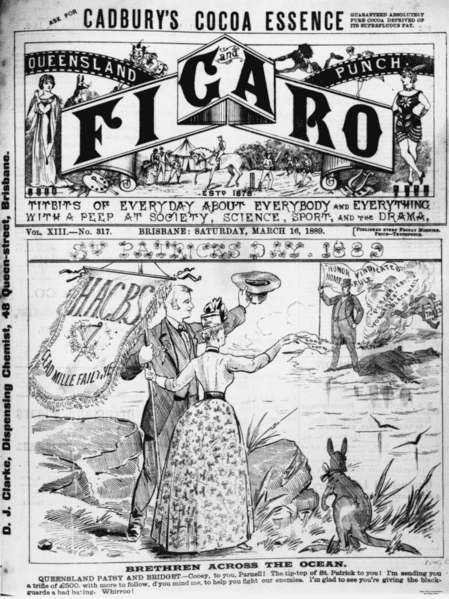
Caricature depicting Irish Australians offering enthusiastic support to Parnell's struggle for Home Rule
FIRST IRISH HOME RULE BILL
- The bill was the first significant attempt by a British government to adopt legislation granting Home Rule to a portion of the United Kingdom of Great Britain and Ireland.
- It was proposed on April 1886 by Gladstone to establish a devolved parliament for Ireland that would rule the country in specific sectors.
SECOND IRISH HOME RULE BILL
- The first bill was defeated in the House of Commons, while the second bill was passed in the House of Commons but vetoed by the House of Lords.
THIRD IRISH HOME RULE BILL
- After the House of Lords’ defeats, the Third Irish Home Rule Bill was passed under the Parliament Act and received royal assent as the Government of Ireland Act 1914. However, it never came into effect due to the First World War and the Easter Rising in Dublin.
FOURTH IRISH HOME RULE BILL
- Northern Ireland was founded as a Home Rule entity inside the United Kingdom of Great Britain and Ireland, and an attempt was made to establish Southern Ireland as another territory. Still, the Irish Free State Constitution Act of 1922 divided Ireland and Irish independence.
- The Conservatives ruled for 10 years after the 1895 general election. Following the English Act of 1888, the crucial Local Government Act 1898 provided the enfranchisement of local electors for the first time, resulting in a system of localised Home Rule in many places.
- The Liberals returned with an overwhelming majority in the 1906 general election. Still, Irish Home Rule was not on their agenda until after the second general election in 1910, when the nationalist Irish Parliamentary Party, led by John Redmond, controlled the House of Commons.
- Prime Minister HH Asquith agreed with Redmond that if he supported his move to destroy the Lords’ control, Asquith would submit a new Home Rule bill.
- The Parliament Act 1911 compelled the Lords to consent to a reduction in their powers. Their unrestricted veto was then replaced with a two-year wait.
- Unionists headed by Sir Edward Carson organised the Ulster Covenant, signed by nearly 500,000 people signifying their rejection of the Third Home Rule Bill.
- Except for the All-for-Ireland Party, Nationalists and Republicans dismissed Unionist concerns with no concessions for Ulster, dismissing their threat as a bluff.
- The Third Home Rule Bill got royal assent and was placed on the statutory books in September 1914, but it was deferred for no longer than First World War, which had broken out in August, under the Suspensory Act.
HOME RULE CRISIS
- With Ireland’s entry into the First World War, the southern Irish Volunteers merged with the larger National Volunteers. They willingly enlisted in Irish battalions of Kitchener’s New Service Army, responding to Redmond’s demand to help the Allied war effort to ensure the future implementation of Home Rule. The Ulster Volunteers were assigned to the 36th Ulster Division. Irish regiments suffered heavy losses between 1914 and 1918.
- The Easter Rising of 1916 in Dublin was staged by a core portion of the remaining Irish Volunteers who opposed the nationalist constitutional drive towards independence and Irish support for the war effort.
- At first, the government’s handling of the aftermath of the Easter Rising, including the hurried executions of its leaders by General Maxwell, was widely condemned in both Britain and Ireland, resulting in a surge in popularity for Sinn Féin, an Irish Republican movement led by Easter Rising survivors.
- Britain made two abortive attempts to establish Home Rule. Both failed due to Ulster Unionists’ opposition to its intended adoption for the entire island of Ireland, first after the Easter Rising and subsequently at the end of the Irish Convention of 1917–1918.
FAILURE OR SUCCESS?
- Sinn Féin won a majority of 73 Irish seats in the general election after the First World War ended in November 1918, with 25 of these seats going uncontested. The IPP was decimated, with only six seats remaining and it was quickly disbanded. Twenty-seven Sinn Féin MPs gathered in Dublin and declared themselves an independent parliament of an Irish Republic in January 1919. Britain chose to disregard this. The result was the Irish War of Independence.
- Northern Ireland’s Home Rule Parliament was established in June 1921. At its opening in Belfast City Hall, King George V delivered a renowned appeal for Anglo-Irish and North-South reconciliation.
- The Northern Ireland Parliament was in operation until March 1972, when the Northern Ireland Office suspended it in favour of direct rule during The Troubles, an ethnic-nationalist conflict in Northern Ireland. It was later repealed by the Northern Ireland Constitution Act 1973.
- Various iterations of the Northern Ireland Assembly re-established Home Rule in 1973–74, 1982–86, 1998–2002 and 2007 onwards. The Assembly tries to balance the interests of the Unionist and Republican factions through a power-sharing agreement.
Image Sources
- https://en.wikipedia.org/wiki/File:Home_Rule-_%27Oh!_Henry_where_did_you_get_that_cigar_and_why_are_you_smoking_it%3F%27_(22906005345).jpg
- https://en.wikipedia.org/wiki/File:Charles_Stewart_Parnell_at_meeting.jpg
- https://en.wikipedia.org/wiki/File:Queensland_Figaro_and_Punch,_cover_16_March_1889.png

